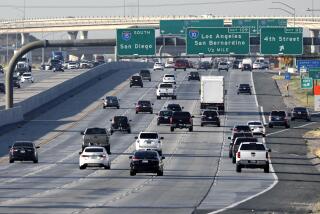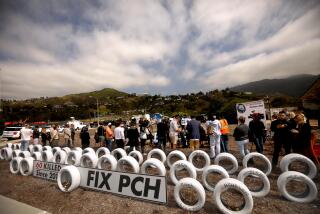Teenagers Often Ignore Seat Belts, With Fatal Results
- Share via
Two brothers on a Southern California freeway at 3:30 a.m. One is wearing a seat belt and the other isn’t when the car slams into a guardrail. The one who isn’t wearing a seat belt is ejected from the car and killed. The other one walks away with minor injuries.
No one knows whether a seat belt would have saved the life of Andre Stewart, the Newport Harbor High School football star who died a week ago in a crash on the Pomona Freeway.
But the contrast is striking between his death and the minor injuries sustained by his half brother Lamar William, who said Stewart was not wearing his seat belt.
“A lot of crashes are survivable if you’re wearing a seat belt,” said Arline Dillman, a traffic safety manager for the Automobile Club of Southern California. “But the teenagers don’t see it that way. They don’t think of themselves as being vulnerable to either crashing or dying.”
Automobile deaths of California teenagers who weren’t wearing seat belts have stayed constant for several years, while the numbers have fallen for the general public.
California Highway Patrol statistics show that in 1997 and 1998, teenager deaths in the state increased slightly, from 103 to 117, while the numbers for all ages decreased from 729 to 683.
Young drivers--the 16- to 24-year-old group--are the least likely of all age groups to wear seat belts, according to studies by the National Highway Traffic Safety Administration. Not quite half of this group wears seat belts, compared with 62% overall.
Overall, however, more Californians use seat belts than motorists nationwide, because of strict state laws that allow officers to pull drivers over for seat belt violations.
In many states, officers can ticket someone for failing to use a seat belt only if they already have pulled over the motorist for another infraction. A 1999 CHP study found the compliance rate in the state to be 90%, though that figure was not broken down by age groups.
But some local high school students said they or their friends don’t always use seat belts because they forget, they don’t care or they don’t think they’ll get into accidents.
A junior at Huntington Beach’s Edison High School, who asked to remain anonymous, said he wears his seat belt only when he feels like it, although he has been cited for not buckling up.
“If I wear it, I wear it. If I don’t, I don’t,” the teenager said. “I think the [seat belt] law is stupid. It’s your own life.”
Teenagers are especially in danger because statistics show that young drivers are more likely to be involved in collisions than others, said Department of Motor Vehicles spokesman Evan Nossoff.
Drivers between 16 and 19 are 2.8 times more likely to be at fault in a fatal collision than the average driver, Nossoff said.
And while members of the same age group make up about 4% of the state’s driving population, they account for almost 13% of drivers blamed for fatal and injury accidents, according to CHP figures from 1996 to 1998.
Other teenagers interviewed in the Edison parking lot after school said they wear their seat belts--but their friends often don’t.
“Most of the time, my friends don’t unless they see me putting on my seat belt,” said Minh Le, a freshman. “I think it’s because they don’t think they’ll be able to get into an accident.”
And another student described an exchange she had with a friend who sat unbuckled behind the wheel:
“I was like, ‘What if you get into an accident?’ and they were like, ‘Oh well,’ ” said Jenna Schmidt, 15.
(BEGIN TEXT OF INFOBOX / INFOGRAPHIC)
Seat Belt Use
A 1996 national survey, conducted by observing vehicle occupants at 2,006 randomly selected intersections, found young adults have the lowest rate of seat belt use.
*
Infant (younger than 1 year): 85.2%
Toddler (1 to 4): 60.1%
Youth (5 to 15): 64.6%
Young adult (16 to 24): 49.5%
Adult (25 to 69): 62.4%
Seniors (older than 69): 68.8%
*
Source: National Highway Traffic Safety Administration
More to Read
Sign up for Essential California
The most important California stories and recommendations in your inbox every morning.
You may occasionally receive promotional content from the Los Angeles Times.













